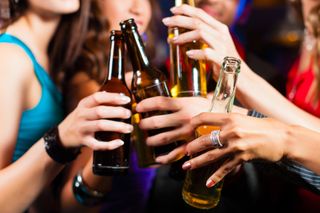Round for Round: Women's Drinking Rates Catching Up to Men's

Men still drink more than women in the United States, but the gap is closing, a new report finds.
Over the decade-long period between 2002 and 2012, the percentage of U.S. women who reported drinking in the past month increased, and so did the the average number of days that women reported drinking, according to the report from researchers at the National Institute of Alcohol Abuse and Alcoholism (NIAAA).
The percentage of women who reported drinking alcohol in the past 30 days increased from 45 percent to 48 percent over the study period. Among men, however, the percentage decreased slightly, from 57 percent to 56 percent, according to the findings published today (Nov. 23) in the journal Alcoholism: Clinical and Experimental Research. [7 Ways Alcohol Affects Your Health]
The average number of days that women reported drinking in the past month increased from 6.8 to 7.3 days, whereas in men, there was a slight decrease, from 9.9 to 9.5 days, the researchers discovered.
"We found that over [the study period], differences in measures such as current drinking, number of drinking days per month, reaching criteria for an alcohol use disorder and driving under the influence of alcohol all narrowed for females and males," Aaron White, the senior scientific advisor to the NIAAA director and lead author on the study, said in a statement.
"Males still consume more alcohol, but the differences between men and women are diminishing," White said.
The evidence of increasing alcohol use is particularly concerning given that women are at greater risk than men for a variety of alcohol-related health effects, including liver inflammation, heart disease, neurotoxicity and cancer, George Koob, the director of the NIAAA, said in a statement.
Sign up for the Live Science daily newsletter now
Get the world’s most fascinating discoveries delivered straight to your inbox.
The researchers noted that the rates of alcohol use disorder and driving under the influence did not increase for women.
In fact, the percentage of women who met the criteria for an alcohol use disorder decreased slightly, and the percentage of men who met the criteria decreased significantly, from 10.7 percent to 9 percent, according to the report.
Similarly, the percentages of both women and men who reported driving under the influence of alcohol decreased over the study period, from 10.3 percent to 7.9 percent in women, and from 19 percent to 14.4 percent in men, according to the report.
The report also touched on binge drinking. Among 18- to 25-year-olds who were not in college, the percentage of women who reported binge drinking significantly increased, while the percentage of men who reported binge drinking significantly decreased. Binge drinking (defined as drinking five or more drinks on the same occasion) rates among 18- to 25-year olds who were in college did not change over the study period, according to the report.
Follow Sara G. Miller on Twitter @SaraGMiller. Follow Live Science @livescience, Facebook & Google+. Originally published on Live Science.

